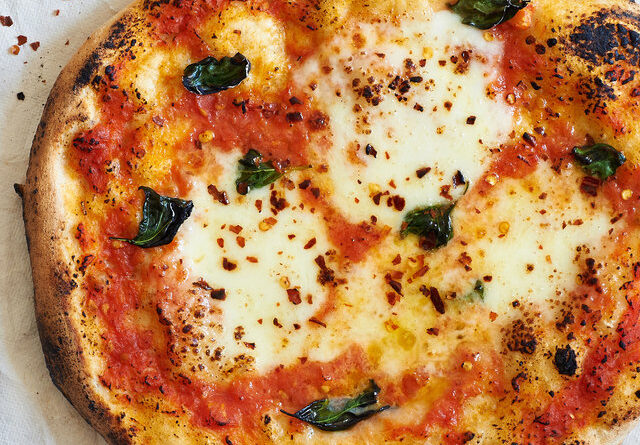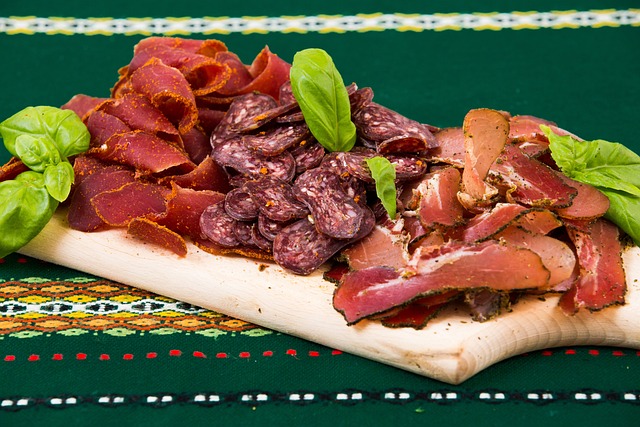
So, you want to learn how to make the perfect French toast, huh? Well, you’re in luck because today I’m going to share all my secrets with you. This classic breakfast dish is not only delicious but also incredibly easy to make. Trust me, once you master this recipe, you’ll become the go-to person for brunches and breakfasts. In this article, I’ll walk you through the step-by-step process of making the fluffiest, most decadent French toast you’ve ever tasted.
Now, let’s get into the nitty-gritty of making the perfect French toast. First things first, you’ll need some key ingredients. Get your hands on some thick slices of bread, preferably brioche or challah to really elevate the flavor and texture. Then, gather eggs, milk, vanilla extract, cinnamon, and a pinch of salt. These ingredients are what create the magical custard mixture that will soak into the bread to create that irresistibly soft and flavorful French toast.
The next step is all about preparing your custard mixture. In a shallow dish, whisk together the eggs, milk, vanilla extract, cinnamon, and salt. Make sure everything is well combined to ensure an even distribution of flavors. Now comes the fun part – dipping the bread into the custard mixture. Take each slice of bread and soak it in the mixture for about 30 seconds on each side. This allows the bread to absorb all that deliciousness and ensures that every bite is bursting with flavor.
To cook your French toast, heat a non-stick skillet or griddle over medium heat and add a pat of butter or a drizzle of oil. Once the butter has melted or the oil is hot, place the soaked bread slices onto the skillet. Cook for about 2-3 minutes on each side, or until golden brown and crispy. You want to achieve that perfect balance of a crispy exterior and a soft, custardy interior. Once cooked, serve your French toast with your choice of toppings such as syrup, fresh fruits, whipped cream, or powdered sugar. Trust me, this breakfast treat will have everyone asking for seconds.
In this article, I’ve covered the basics of making the perfect French toast. But, if you want to take your culinary skills to the next level, I highly recommend checking out the full recipe. You’ll learn some additional tips and tricks that will guarantee your French toast game is on point. So, get ready to impress your friends and family with a plate of fluffy, delicious French toast that they won’t be able to resist.
Table of Contents
How to Make Perfect French Toast
Making French toast may seem simple, but achieving the perfect balance of flavors and textures can be a challenge. Follow this step-by-step guide to learn how to make the perfect French toast every time. Whether you prefer a classic sweet version or want to explore savory twists, this recipe has something for everyone. So, gather your ingredients and let’s get started!
Gathering Ingredients
Choosing the Bread
The foundation of a great French toast starts with choosing the right bread. Opt for thick slices of bread that can absorb the custard mixture without becoming too soggy. Brioche, challah, or French bread are excellent choices. If you want to try a savory twist, consider using sourdough or whole-grain bread.
Eggs and Milk
The key to a rich and creamy custard mixture lies in using the right combination of eggs and milk. In a medium bowl, crack the eggs and whisk them until the yolks and whites are fully combined. For every four slices of bread, use about four large eggs and half a cup of milk. Whole milk works best, but you can also substitute with cream or a non-dairy alternative, such as almond or oat milk.
Adding Flavorings
Now is the time to infuse your French toast with delicious flavorings. To achieve a classic sweet version, add a teaspoon of vanilla extract and a pinch of cinnamon to the custard mixture. If you’re feeling adventurous, experiment with other spices like nutmeg, cardamom, or even a touch of cocoa powder for a chocolatey twist.
Optional Toppings
French toast is like a blank canvas ready to be adorned with a variety of toppings. Classic choices include a dusting of powdered sugar, a drizzle of maple syrup, or a dollop of whipped cream. For a healthier option, try adding fresh fruits like berries or sliced bananas. And for an indulgent treat, why not top it off with a scoop of your favorite ice cream?
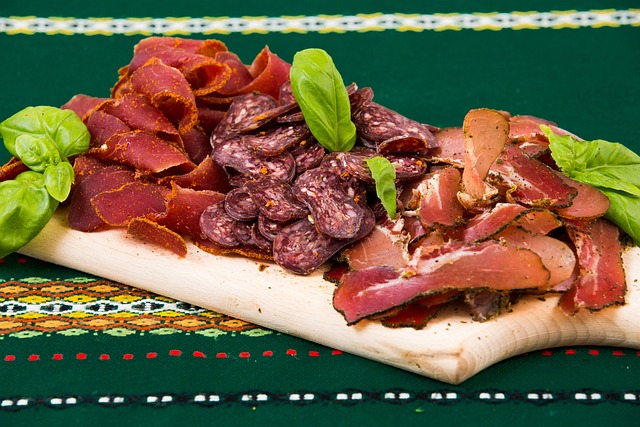
Preparing the Custard Mixture
Cracking and Whisking Eggs
Crack the eggs into a medium-sized bowl, making sure to remove any shell fragments that may have fallen in. Use a whisk to beat the eggs thoroughly until the yolks and whites are well combined. This step ensures a smooth and even custard mixture.
Adding Milk and Flavorings
Pour the milk into the bowl with the beaten eggs. Add the vanilla extract and any other desired flavorings, such as cinnamon or nutmeg. Whisk everything together until the ingredients are fully incorporated. The milk helps create a creamy texture while the flavorings infuse the custard mixture with delectable tastes.
Mixing Well
To achieve a custard mixture that coats the bread evenly, make sure to mix well. Soak a slice of bread in the custard mixture for a few seconds, then flip it over to coat the other side. Repeat this process for all the bread slices, ensuring each slice gets ample time to absorb the mixture.
Adjusting Consistency
If the custard mixture seems too thick, add a splash of milk and whisk until the desired consistency is reached. Conversely, if it seems too runny, beat another egg separately and gradually add it to the mixture until the desired thickness is achieved. This step ensures that your French toast cooks evenly and has a delightful texture.
Dipping the Bread
Preheating the Skillet
Before you start cooking the French toast, preheat a non-stick skillet or griddle over medium-low heat. This allows for even cooking and helps prevent the toast from sticking to the pan.
Soaking the Bread Slices
Dip each slice of bread into the custard mixture, making sure both sides are coated. Let the bread soak for about 20 seconds on each side. This soaking time allows the bread to absorb the custard mixture, resulting in a moist and flavorful French toast.
Coating Both Sides
To ensure a golden and crispy exterior, make sure to coat both sides of the bread evenly. Gently shake off any excess custard mixture and transfer the soaked slice to the preheated skillet. Repeat this step for the remaining bread slices, ensuring not to overcrowd the skillet.
Avoiding Sogginess
To prevent your French toast from becoming soggy, do not soak the bread slices for too long or pile them up on a plate. Cooking the bread immediately after soaking allows the custard mixture to set properly and avoids any sogginess.
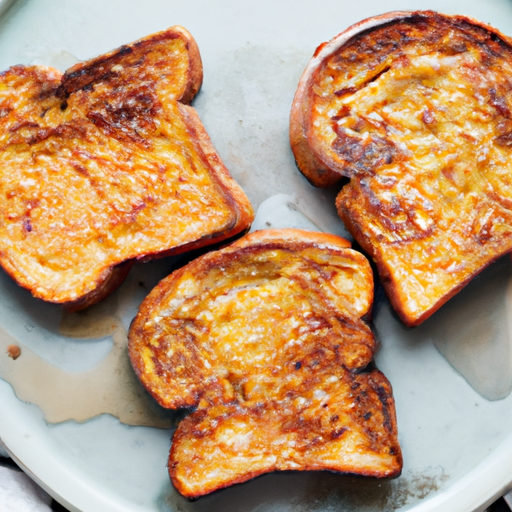
Cooking on the Stovetop
Melting Butter in the Skillet
Add a pat of butter to the preheated skillet and let it melt completely. The butter adds a rich flavor and helps achieve a beautiful golden crust on the French toast slices. Swirl the melted butter around the skillet, ensuring it evenly coats the entire cooking surface.
Placing the Bread Slices
Carefully transfer the soaked bread slices to the skillet, making sure they lay flat and are not folded or twisted. Leave some space between each slice to ensure even cooking. Cook the bread over medium-low heat for about 3-4 minutes per side or until golden brown.
Flipping at the Right Time
When the first side of the French toast turns golden brown, gently flip it over using a spatula. The cooked side should be crisp and lightly caramelized. Cook the other side for an additional 3-4 minutes until it achieves the same golden color and crispy texture.
Removing from Heat
Once both sides are cooked to perfection, carefully remove the French toast from the skillet and transfer it to a serving plate. Repeat the cooking process with the remaining bread slices, adding more butter to the skillet if needed. Keep the cooked French toast warm in the oven while you prepare the rest.
Baking in the Oven
Preheating the Oven
Preheat your oven to a low temperature, around 250°F (120°C). This step is crucial for maintaining the warmth and crispiness of the French toast while you cook multiple batches or if you just want to serve it all at once.
Placing the Dipped Bread
After the bread slices are soaked in the custard mixture, place them on a wire rack set inside a baking sheet. This setup allows for even heat circulation and prevents the bottom of the French toast from becoming soggy. Place the baking sheet with the prepared bread slices in the preheated oven.
Baking Time and Temperature
Bake the French toast for about 15-20 minutes or until the slices are hot and cooked through. The low temperature ensures that the custard mixture sets without burning the bread. Baking the French toast in the oven also gives it a deliciously crispy texture.
Achieving Crispy Texture
If you prefer a crispier French toast, you can briefly broil it for about 1-2 minutes after baking. Keep a close eye on the toast during broiling to avoid burning. This step adds a delightful crunch to the exterior while maintaining a soft and fluffy interior.
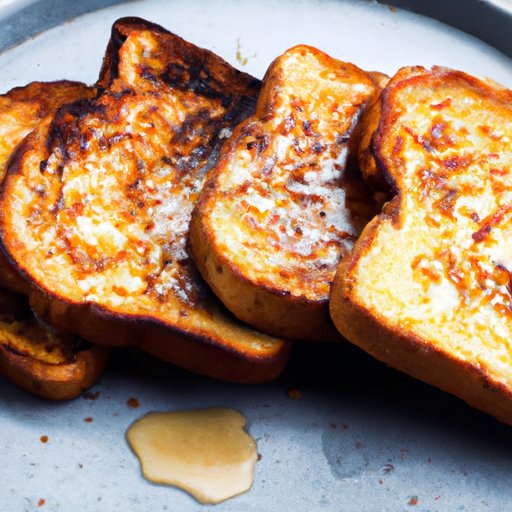
Adding Finishing Touches
Dusting with Powdered Sugar
Before serving, dust your French toast with powdered sugar for an extra hint of sweetness. Use a sieve or a fine-mesh strainer to evenly distribute the sugar on top of the toast. This not only adds visual appeal but also enhances the overall flavor and presentation.
Drizzling with Syrup
For a classic touch, drizzle your French toast with maple syrup. The sweet and sticky syrup complements the flavors of the toast perfectly. If you want to explore different flavors, try fruit syrup, honey, or even flavored syrups like caramel or chocolate.
Adding Fresh Fruits or Berries
Add a burst of freshness and color to your French toast by topping it with fresh fruits or berries. Sliced strawberries, blueberries, or raspberries are popular choices. Their natural sweetness balances the richness of the toast and adds a delightful contrast in texture.
Whipped Cream or Ice Cream
To take your French toast to the next level of indulgence, serve it with a dollop of whipped cream or a scoop of your favorite ice cream. The creamy and airy texture of the whipped cream or the cold, velvety ice cream pairs beautifully with the warm and decadent French toast.
Experimenting with Flavor Variations
Cinnamon and Vanilla
If you want to stick to the classic sweet version, but with a little twist, mix in some ground cinnamon and vanilla extract into your custard mixture. The warm and aromatic flavors of cinnamon perfectly complement the sweetness of the French toast.
Orange Zest and Nutmeg
For a citrusy and spiced variation, add some freshly grated orange zest and a pinch of nutmeg to your custard mixture. The fragrance of the orange zest and the warmth of nutmeg create a tantalizing combination that will make your French toast truly memorable.
Maple and Pecan
For a delightful autumnal treat, replace the regular milk with maple syrup in your custard mixture. The sweet and smoky notes of maple syrup pair exceptionally well with the toasty and nutty flavors of crushed pecans. Top your French toast with these heavenly pecans for a delightful crunch.
Chocolate and Hazelnut
If you’re a chocolate lover, why not indulge in a Nutella-infused French toast? Spread a generous amount of Nutella between two slices of bread before dipping them into the custard mixture. Cook as usual, and the result will be an ooey-gooey, chocolaty delight that will satisfy any sweet tooth.
Making a Savory Twist
Using Savory Bread
To create a savory French toast, swap the sweet bread with a savory option like sourdough or whole-grain bread. The heartiness of these bread options perfectly complements savory toppings and fillings.
Swapping Sugar with Salt
Replace the sugar in the custard mixture with a pinch of salt and a dash of black pepper. This savory twist enhances the flavors of herbs and spices, making it an excellent choice for those looking to enjoy French toast for breakfast or brunch without the sweetness.
Adding Herbs and Spices
Incorporate herbs and spices into your custard mixture to create a savory French toast bursting with flavor. Experiment with combinations like chives and dill, garlic and thyme, or even curry powder and turmeric.
Serving with Savory Toppings
Complete your savory French toast with toppings like crispy bacon, sautéed mushrooms, grilled tomatoes, or a sprinkle of grated cheese. The possibilities are endless, and you can customize your toppings to suit your preferences.
Tips for Perfect French Toast
Choosing the Right Bread
Selecting the right bread is crucial for achieving perfect French toast. Choose thick slices of bread that can absorb the custard mixture without becoming too soggy.
Using Stale Bread
If you don’t have stale bread on hand, lightly toast your slices before dipping them into the custard mixture. This step prevents the bread from becoming overly mushy during soaking.
Working with Different Egg-to-Milk Ratios
Experiment with different egg-to-milk ratios to achieve your desired level of richness and firmness in the custard mixture. Adjust the amounts of eggs and milk according to your preferences.
Controlling Cooking Heat
Cook the French toast over medium-low heat to ensure even browning without burning. This gentle cooking method allows the custard mixture to set properly and avoids a raw center.
Conclusion
Congratulations! You’ve learned how to make the perfect French toast. Whether you prefer the classic sweet version or want to explore savory twists, this versatile dish is sure to impress. Remember to choose the right bread, create a flavorful custard mixture, and cook it to perfection. So, gather your ingredients, follow the steps, and savor every bite of your homemade French toast creation. Share this delightful breakfast or brunch dish with your friends and family, and enjoy the satisfying and delicious outcome. Happy cooking!


